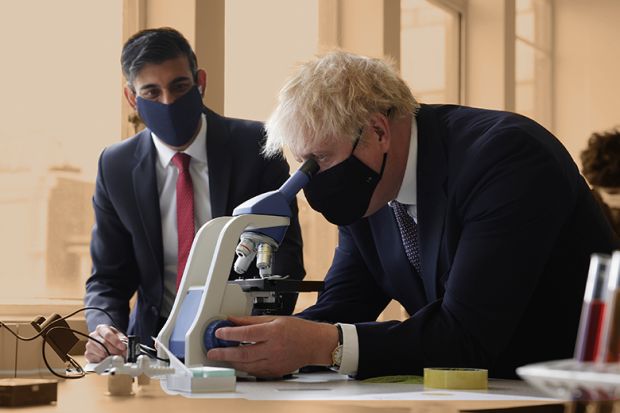After the rhetorical heat of the Conservative Party conference, the publication of the UK spending review on 27 October should be a point of light – bringing the clarity of a Treasury spreadsheet to the government’s programme for the next three years.
For higher education and research, a lot is at stake. And having set itself the unusually concrete target of investing £22 billion in R&D by 2024-25, the government needs to explain how it will move from current levels – around £15 billion – in three short, steep jumps. All this is happening as the wider economic seas get ever choppier in the wake of Brexit and the pandemic.
Government instability since the Brexit referendum, followed by the economic shock of Covid-19, means that this will be the first comprehensive three-year spending review since 2015. There is a tendency for such reviews to set unrealistic targets, but any certainty is better than none. That is particularly true as the prime minister’s ambitions extend far beyond ensuring the UK’s status as a “science superpower”, to encompass “levelling up” the economy, fixing social care, tackling the NHS backlog and investing in skills – to highlight just a few.
Ahead of the first spending review of the coalition government in 2010, the research community was braced for cuts of 10, 15 or 20 per cent, in line with the austerity agenda. When a flat-cash settlement was instead announced, The Times newspaper hosted a party for 200 leading lights of UK research, where science minister David Willetts and chief scientist John Beddington were cheered like conquering heroes.
This time around, there are also three less optimal scenarios, which we might summarise in a flurry of Johnsonian alliteration as a fudge, a fiddle and a falling short.
A fudge would be some form of extended ambiguity – a tactic the Treasury sometimes employs. Universities, science bodies and businesses speak with one voice of the need for predictability, alongside growth, in research and development funding following several years of policy turbulence and faddishness. But will they be heard?
A fiddle would be a clever change to the public accounting rules that allows the government to argue that it’s already investing more in R&D than it actually is. There is perhaps scope to look more creatively at how we define and measure R&D in relation to the broader target of investing 2.4 per cent of gross domestic product in it by 2027. There is also a case for counting universities’ internal investments in research – estimated at between £2.5 billion and £4.7 billion a year. But while there are also several options to fiddle the figures on the £22 billion public spending target, all would corrode confidence in the UK R&D system. Better would be to fall short: to acknowledge that economic pressures necessitate a rethink, either of the target or its delivery time frame.
As well as the survival of the £22 billion commitment, a positive outcome would involve a more coherent, long-term strategy for the R&D system: how the government envisages the different pieces working together. The R&D Roadmap process, initiated last summer, looked as if it might become a point of strategic consolidation, but it has ended up a road to nowhere.
The past four years have seen a lot of upheaval. The 2018 consolidation of public funding under UK Research and Innovation (billed by the PM’s brother, Jo Johnson, as the biggest reform for a generation) has been superseded by fragmentation through the creation of the Advanced Research and Invention Agency, an £800 million work-in-progress, without a defined rationale. Challenge funds for industrial strategy and global issues have been launched and then withdrawn or rebadged with little warning. And the UK still lacks a signed association agreement for the European Union’s Horizon Europe programme – and a clear way of paying the bill.
Yet a further review of the R&D landscape has now been initiated by No 10 adviser James Phillips – who did his PhD at the Howard Hughes Medical Institute’s innovative Janelia Research Campus. Chaired by UKRI architect and Francis Crick Institute chief executive Sir Paul Nurse, this seems likely to push for more investment in novel institutions and structures.
Meanwhile, the Cabinet Office’s new Office for Science and Technology Strategy has started scouring the horizons for strategic opportunities that align with government priorities. These were set out in March’s Integrated Review of Security, Defence, Development and Foreign Policy, the clearest articulation yet of “science superpower” ambition.
There are good arguments for greater institutional and structural diversity, but also for more consolidation and investment in what is already working. This is what Germany is doing: steadily growing investment from both public and private sources to reach an R&D intensity of 3.1 per cent of GDP. That saw German universities receive €23.7 billion (£20.1 billion) in basic research funding and €8.7 billion in third-party funding in 2019.
This is – as the UK chancellor who oversaw the last long-term R&D framework back in 2004 might have put it – less flash and more Gordon. It is the kind of solid foundation needed to build a genuine science superpower.
James Wilsdon is Digital Science professor of research policy at the University of Sheffield and director of the Research on Research Institute (RoRI).
POSTSCRIPT:
Print headline: UK research needs certainty after autumn of political reckoning
Register to continue
Why register?
- Registration is free and only takes a moment
- Once registered, you can read 3 articles a month
- Sign up for our newsletter
Subscribe
Or subscribe for unlimited access to:
- Unlimited access to news, views, insights & reviews
- Digital editions
- Digital access to THE’s university and college rankings analysis
Already registered or a current subscriber? Login








